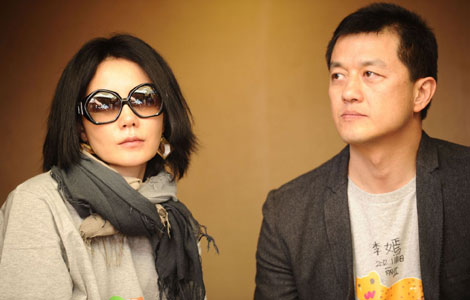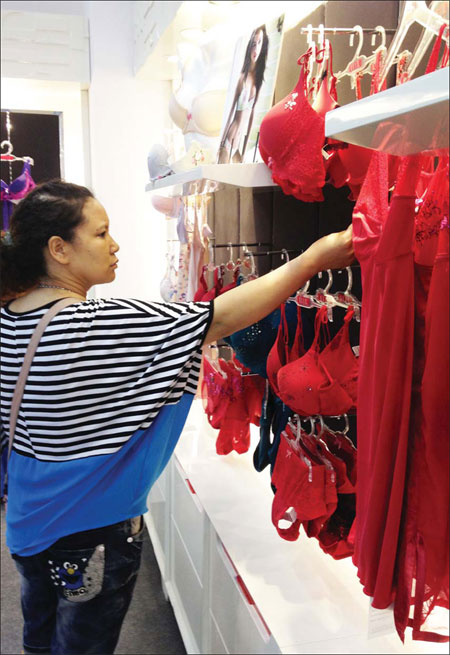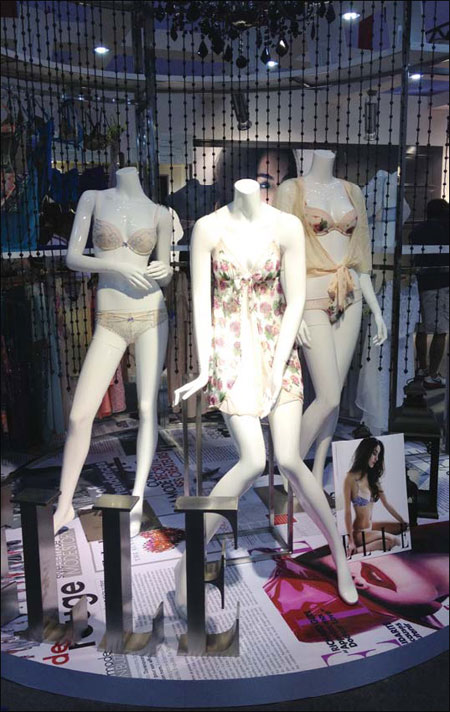Surviving with the bare essentials
Updated: 2013-08-23 10:35
By Yao Jing (China Daily)
|
|||||||||||
|
The demand for underwear was less affected by the economic downturn in China due to the products' affordable prices. Yao Jing / China Daily |
|
Foreign lingerie brands adjust designs to cater to Chinese consumers. Yao Jing / China Daily |

Underwear makers in China are left vulnerable as tastes swing to foreign brands
There's a fine, frilly line between what is underwear and what is lingerie. On one side there is simple functionality and comfort; on the other, glamor and effect. And each incorporates a good part of the other.
Chinese consumers, once very much on the basic side, have of late been striding confidently upmarket as women seek more in the way of sophistication and less in pure practical terms.
But for the makers and sellers of underwear, the changes in the market are anything but elegant or glamorous. Competition is fierce, it's a tough scene and very unbecoming.
As with so many products, foreign brands have the edge, but where before they used Chinese manufacturers, many have now moved to other Asian countries for production, as various costs in China increase.
Chinese companies are left fighting among themselves, struggling for brand identity. Factories that used to produce good-quality pieces cheaply for established brands, are registering their own, hoping for a bit of a lift on the domestic scene - but there are so many of them, and still having to cater for demand for smart but basic underwear.
"Chinese manufacturers are very efficient, and the quality of craftsmanship you get for the price is quite good," says Sergio Flores Bonamaso, general manager of Promise S.A., a Spanish lingerie company that has been using Chinese manufacturers for more than 10 years.
"But our business here is somewhat difficult because there are so many brands, and everyone in the world wants to sell in China."
With a flagging market in Europe, last year Promise decided to enter the Chinese one, signing a deal with a new manufacturer.
Retail turnover in the Chinese underwear market rose 13 percent last year compared with the year before. Compared with outerwear and footwear, the demand for underwear was less affected by the economic downturn. This was due to comparatively affordable prices and the less discretionary nature of the product, says companiesandmarkets.com.
More than 40 percent of Chinese underwear customers are aged 25 to 44, an age group expecting higher income as the Chinese economic boom continues, according to Global Underwear Market Report 2012 issued by US-based Research and Markets.
For the 44-year-old family-owned Promise, which had revenue of 20 million euros last year, China therefore is promising ground for further growth.
"We are growing at an average rate of 10 percent year-on-year," Bonamaso says. "The European market is slowing down, but the United States and China are catching up."
It has been a slow start, with China accounting for very little of the company's turnover. He reckons it will take another five years to cultivate the market.
"We have signed contracts with 15 provincial agents and have outlets in eight shopping malls in Shenzhen," he says.
Promise's product sets, which include lingerie, nightwear and shapewear, range in price from 300 yuan ($49; 37 euros) to 800 yuan.
Also last year, Lepoux, a French underwear brand, sashayed into the Chinese market through its agent, Hong Kong-based Glamorous Apparel Ltd.
Although the 30-year-old brand is positioned as a lower-end one in France, it is targeting middle to top-end consumers in China.
One set of nightwear or lingerie, which it says combines a touch of old Hollywood glamour with contemporary styling and fitting, costs from 400 yuan to 800 yuan.
"We have set up six selling points in Shenzhen, Guangzhou and Huizhou," says He Qiming, a regional manager for Glamorous Apparel.
"In 2012 we had income of about 3 million yuan from our three stores in the first year. This year, as we sped up opening new stores, the sales volume has doubled."
He says they will focus on opening specialty stores and placing goods in department stores in major cities such as Shanghai, Wuhan and Chongqing.
"To cater to the local market, we are also adjusting some of the designs according to Asian women's body characteristics."
Elle, another French lingerie brand, has been benefiting from the evolving tastes of Chinese women for much longer. It was brought to China by Guangzhou B. Lingerie Trading Co Ltd in 2006, though they had to wait a while for the market to change.
"From 2006 to 2008, we had consecutive negative growth because most Chinese women were tending to choose simple and plain underwear," says Shi Guoliang, franchise supervisor of the company. "Our products, with large areas of lace and bright colors, were regarded as too showy.
"But after gaining experience of the market and establishing a complete sales channel, we began to develop franchising around the country. Sales grew 30 percent a year after 2010. By the end of last year, we had opened 180 direct selling shops."
Elle, which has been developing tailored shapewear, is also launching a new range, Opus, for younger women later this year.
"In the past, we just wanted to sell as many products as possible. But today we are paying more attention to consumers' needs, because the competition is becoming severe," says Shi.
Elle, however, imports all its laces from Germany, and has moved production elsewhere in Southeast Asia to lower costs.
In the face of such showy foreigners, Chinese makers are inevitably trying to join the branding game to overcome losses in manufacturing contracts.
However, although they are skilled in production and know the market better, they are having to proceed cautiously as well as cleverly.
Bi Quanyong paid hundreds of thousands of yuan to register a lingerie brand, Royal's, in Italy in 2005. But he brought it back to China without even a sales trial in Europe.
With a factory in Zhongshan, Guangdong province, Bi has opened 500 selling points around the country in the past decade.
"Our turnover is increasing at an average rate of 30 percent year-on-year," he says.
However, Bi says the brand did not really begin to catch until 2010, when he paid more attention to the quality and design and raised the price to about 300 yuan from 100 yuan.
"We employed an Italian designer that year," he says. "Before then, all our products were sold in small specialty stores. But high-end shopping malls and department stores are still very difficult for us to get into. We have to further improve the brand to make it more recognizable."
Another time-honored Chinese maker of fine underwear, Gujin, decided to front up in fashion shows in Paris and hometown Shanghai to give more cachet to its brand.
"Right now, the market is flooded with brands, but I think the local market will connect with the international market in less than five years," says Wang Hui, deputy manager of Gujin's market operation department. "Until then, we will be standing on the same stage with foreign brands.
"We have opened boutique stores in Singapore, and we are planning to step into Europe within three years."
The company also provides lace and strings for the Victoria Secret lingerie company.
Wang believes the intense battle within the Chinese underwear market is necessary to eliminate underperforming brands and establish order.
yaojing@chinadaily.com.cn
(China Daily European Weekly 08/23/2013 page14)
Today's Top News
List of approved GM food clarified
ID checks for express deliveries in Guangdong
Govt to expand elderly care
University asks freshmen to sign suicide disclaimer
Tibet gears up for new climbing season
Media asked to promote Sino-Indian ties
Shots fired at Washington Navy Yard
Minimum growth rate set at 7%
Hot Topics
Lunar probe , China growth forecasts, Emission rules get tougher, China seen through 'colored lens', International board,
Editor's Picks

|

|

|

|

|

|







